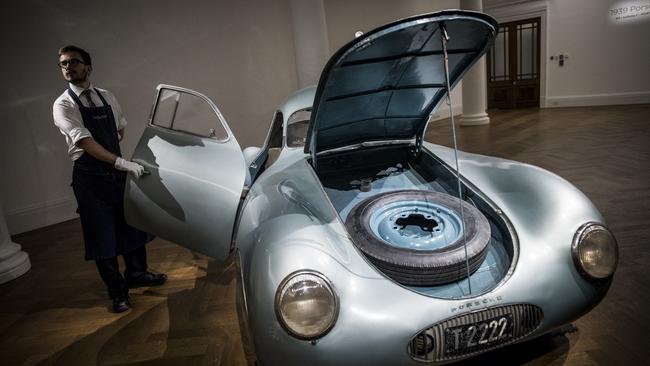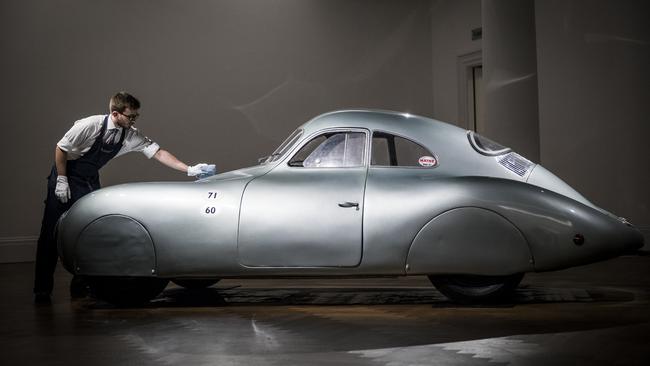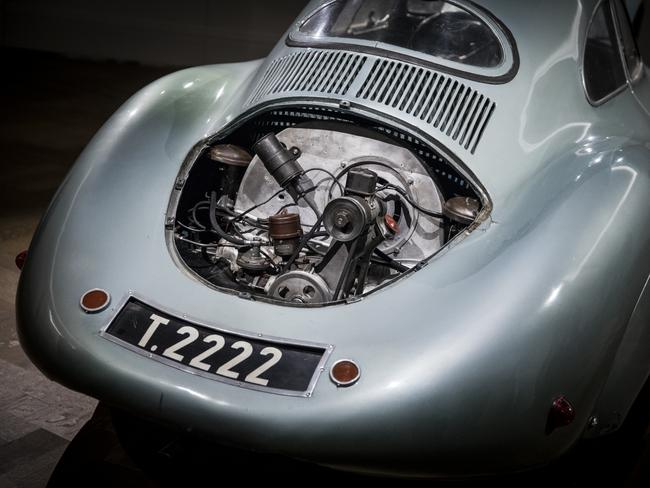Historic car has dubious past
Ferdinand Porsche, who built the 1939 Type 64 Berlin-Rome Rennwagen, was Hitler’s car guy.

Ferdinand Porsche was an enthusiastic National Socialist Party member and Hitler’s car guy. Attempts to portray the founder of Porsche as a reluctant Nazi are misguided and unsupported by the evidence. Among other crimes, Porsche directed wartime production in factories using forced labour and guarded by units of the SS. He was awarded the rank of SS-Oberfuhrer.
So let us, as true lovers of automobiles and history, not kid ourselves about who Porsche really was or to what end he built the 1939 Type 64 Berlin-Rome Rennwagen, the first automobile ever to be named Porsche.
Bound for an extraordinary public auction on Saturday in Monterey, California, this car was designed to compete in a party-sponsored road race publicising the Axis alliance and the autobahn. Its aerodynamic gorgeousness reflects the sophistication of Germany’s warmaking sciences in 1939. For example, its flowing aluminium body is fastened with more than 2000 flush rivets.
But the Type 64 is more than propaganda, more than a bit player in the Worst Story Ever Told. Through an astonishing chain of events, this car (one of three) survived the war to become the founding document of Porsche sports cars. Its proportions, rear-engine packaging, light weight and aerodynamic envelope all point forward in design time, anticipating generations of cars, the empire that lay ahead. This is the face that launched a thousand dealerships.
The Type 64 is also the first iteration of the most successful car design in racing history, the 911 Carrera.
It all starts under the haunches of a morally complaisant genius. Both Ferdinand and his son Ferry used the Type 64 as their personal car during the war and for years afterwards in Germany and Gmund, Austria, where the company sought refuge in late 1944.
RM Sotheby’s received the consignment in May from the anonymous owner, a noted European collector. The Ontario-based auction house has spent some months documenting the car, including shooting video in southern California last week.
While the car was warm and fuelled, so to speak, the company invited me to drive the first Porsche ever. I was available.
Given its significance, this car belongs in a public museum, not a private collection; so why isn’t it?
Why is it not sitting in the new wing of the Deutsches Technikmuseum in Berlin or in Porsche’s own collection in Stuttgart?
The man responsible was a wealthy Austrian enthusiast with a dead arm named Otto Mathe, who bought the car from Ferry Porsche in 1949. Mathe, who had been badly injured in a racing accident, loved the Type 64 and raced it one-handed for several years. Even after he moved on to other race cars, Mathe declined to sell back what became known as the Ahnherr, the ancestor.
Why? No one knows. It may have been a case of wanting to avoid transactions in the tightly knit Austrian financial aristocracy.
“They all knew each other very well,” says Alexander Weaver, RM Sotheby’s assigned specialist and keeper of keys.

Mathe kept the car 46 years before his death in 1995, after which it was acquired by Austrian marque expert Thomas Gruber.
Gruber gave the car a “sympathetic restoration”, the catalogue says, including the beguiling aquamarine finish it wears today.
The consignor bought the car in 2008 and has kept it mechanically alive with a series of restorations, including reuniting the car with its long-lost, and wee, engine.
I met the truck carrying the Type 64 near the docks of Long Beach. RM Sotheby’s handlers gently coaxed the car to life with some carb spray, after which I was invited to have a go.
Don’t get excited. It drives like the very, very old VW it is, except the alloy-reinforced structure is surprisingly stiff and the clutch pedal engagement is mere millimetres.
The time-travelling patina is beyond belief. The crooked block letters on it nose, that became the trademark? Ferry put them on himself and made a hash of it too.
The cloth upholstery is original; the cordwain door pulls are original; brushstrokes on the curved dash and hammer marks from Reutter Karosserie, original.
The artefactual status of this car goes off every scale.
The car is expected to fetch more than $US20 million ($29.4m) at auction, says Weaver. But it is in most respects beyond mere valuation.

Built on a KdF-Wagen chassis — also known as the Beetle — the Type 64 represented Porsche’s daring new calculus of speed.
Compared to the dreadnought Silver Arrows of Auto Union, the car was/is tiny, ultralight, powered by a 985cc, horizontally opposed, four-cylinder engine with twin Solex carbs (roughly 40hp). Weighing just 610kg, the Type 64’s minimalism would have charmed Lotus founder Colin Chapman if he hadn’t been busy ducking buzz bombs at the time.
The Berlin-Rome race, scheduled for September 1939, was cancelled, so we will never know the car’s potential. During the war, Porsche and his driver Josef Goldinger wheeled the car from Berlin to Wolfsburg, a distance of about 225km, averaging 133km/h. But traffic was light in those days.
Does the Type 64’s beauty, patina, technical prescience, its centrality in Porsche’s corporate origin story, its role in bringing joy to millions of motor sports fans for generations, in any way redeem Porsche the man? Hell no.
There is even something disquieting about private collectors bidding to possess such a legacy.
But the car is one of the most important objects on four wheels.
My hope is that it will find its way to a proper museum, where its lessons will remain available to all.
The Wall Street Journal
-
1939 Porsche Type 64 Berlin-Rome Rennwagen
Estimated Value: $29.4 million
Power train: 985cc, horizontally opposed, four-cylinder with two overhead valves per cylinder; four-speed synchromesh transmission; rear-wheel drive
Power/Torque: 40hp at 4000 rpm/ 88nm of torque at 3500 rpm (est.)
Length/Width/Height/Wheelbase: 4.1m/1.77m/1.37m/2.43m
Weight: 0-100km/h: 25 seconds (est.)
Fuel Economy: 8.5km per litre, mixed driving (est.)



To join the conversation, please log in. Don't have an account? Register
Join the conversation, you are commenting as Logout